June 11, 2023
Written by Q.J. Zheng
Report on the 2023 Chinese Religious Text Authority (CRTA) Workshop[1]
In January 2023, eighteen graduate students and early career scholars of Chinese religions gathered in Paris for the four-day international workshop “Outliers and Oddities: Identifying, Contextualizing and Questioning Religious Texts’ Identity”.[2] The workshop was organized as part of the Chinese Religious Text Authority (CRTA) project,[3] with the aim of reading different genres of late imperial Chinese religious texts, and describing and contributing bibliography information of these texts to an online database. The CRTA workshop this year was organized by Daniela Campo (University of Strasbourg) and led by six instructors: Vincent Goossaert (École Pratique des Hautes Études – PSL), Philip Clart (Leipzig University), Katherine Alexander (University of Colorado, Boulder), Marcus Bingenheimer (Temple University), Gregory Adam Scott (University of Manchester), and Wang Huayan (Institut des Hautes Études Chinoises). This event was generously supported by two institutions: the From the Ground Up: East Asian Religions (FROGBEAR) project (University of British Columbia) and the Interdisciplinary Thematic Institute of History, Sociology, Archaeology & Anthropology of Religions (ITI HiSAAR) of the University of Strasbourg.
Day 1: Thursday January 5th
The workshop of the CRTA project began on January 5th at the Maison des Sciences de l’Homme (MSH) in Paris. Vincent Goossaert (École Pratique des Hautes Études – PSL) opened the event by sharing the history, objectives, and future vision of the CRTA project, which encompasses two interconnected initiatives: creating a CRTA database for multiple research projects and fostering an international community of scholars studying Chinese religious texts. The focus of this year’s workshop was to discuss specific, unique texts and to advance the project’s development through training on creating entries for the CRTA database. He expressed gratitude for the generous support from institutions including the FROGBEAR project and the ITI HiSAAR of the University of Strasbourg.
Gregory Adam Scott (University of Manchester) then provided a background of the CRTA project, which was created to collect and organize information on Chinese religious texts. Scholars working in different fields of Chinese religious history usually produce a large amount of data throughout their research. As an example, Scott discussed his personal experience in collecting information for his own research on Buddhist print culture.[4] However, as library catalogues are often inaccurate and insufficient, verified bibliographic information for different sorts of rare primary sources could thus be very useful for other scholars. To achieve this objective, a group of researchers created a centralized tool using MediaWiki: Chinese Religious Text Authority (CRTA)—for collecting data and making it publicly accessible and editable. The project structure is similar to Wikipedia—each entry is an editable wiki page structured to display data derived from authoritative source of information, and has an infobox to show a quick summary of the entry item.
Katherine Alexander (University of Colorado, Boulder) then talked about the direct research impact of the publicly accessible information from CRTA entries. She demonstrated by using her CRTA entry on Pangong mianzai baojuan潘公免災寶卷 [The Precious Scroll in which Mr. Pan [Explains] How to Avoid Catastrophe] as an example, highlighting how it already appears as the second result of a Google search. The top result was from Chinese Text Project,[5] an online repository of Chinese texts, where users might find an OCR transcription of one version of the work, with errors that still need correcting. Because the goal of CRTA is to build connections between these texts and eventually a web of all religious texts, if users click on the CRTA link in response to their query, they will find a detailed description of one specific edition, clearly identified, and links to other editions of the same title. The platform provides space for detailed descriptions of specific data such as format, publication date, and location of publication. The challenge is to crowdsource the data, but Alexander was hopeful that with more contributors, an overall view of these texts will become clearer as more entries are added.
Marcus Bingenheimer’s (Temple University) talk on CRTA and linked open data (LOD) showed us the research potential of Extensible Markup Language (XML) output from the CRTA. He explained the LOD and its standards, specifically mentioning the example of Wikidata. The LOD needs to be accessible, clear in terms of copyright, and structured for computers to process it well. He then mentioned persistent Uniform Resource Identifier (URI) and the MediaWiki Application Programming Interface (API) as two ways to access and download data from Wikidata. The CRTA releases a monthly XML data dump of its data that can be downloaded by anyone, but it is not a complete archive as it does not include page revision histories, user accounts, images, or information on edits. The XML file only includes the current textual content of the wiki. All data on the CRTA is backed up periodically. XML could be used to restore and copy the current textual content of the CRTA website and used for offline searches.
The session was followed by two demonstrations of the application of the CRTA database for research projects. Scott demonstrated how he created a corpus of Chinese Buddhist periodicals from 1912 on the CRTA—the Digital Catalogue of Chinese Buddhism (DCCB). He recorded information on each title, made it publicly accessible, and used it for his own research. Goossaert then presented his use of the CRTA to study religious publishing in Beijing. He demonstrated how one could search for historical figures or institutions involved in publishing by using the advanced search function. As an illustration, he showed us that the data on the CRTA indicated that one of the largest publishers in Beijing was Yongshengzhai 永盛齋 (active 1860–1930). This demonstration highlighted the usefulness of the CRTA for research, providing access to a valuable source of information as the database’s entries may not be found in library records. He also noted that as many universities worldwide are putting their digitized collections online, such as Waseda University, Bibliothèque nationale de France, Harvard University, and the Australian National University, the next phase of the CRTA project will be to add entries for these digitized religious texts to the CRTA corpora.
Next, Philip Clart (Leipzig University) presented the new project “Religious Text Production and Identity Formation in China, 17th to 21st Centuries”.[6] This project is a three-year joint venture funded by the German and French research agencies, Deutsche Forschungsgemeinschaft (DFG) and Agence nationale de la recherche (ANR), as part of their bilateral cooperation scheme from July 2023 to June 2026. The project’s two principal investigators are Philip Clart and Vincent Goossaert. The project is now welcoming applications for two positions for the duration of the project: one doctoral student based in Leipzig, and one postdoctoral researcher based in Paris. Additional information is available online [7] or by contacting the professors directly.
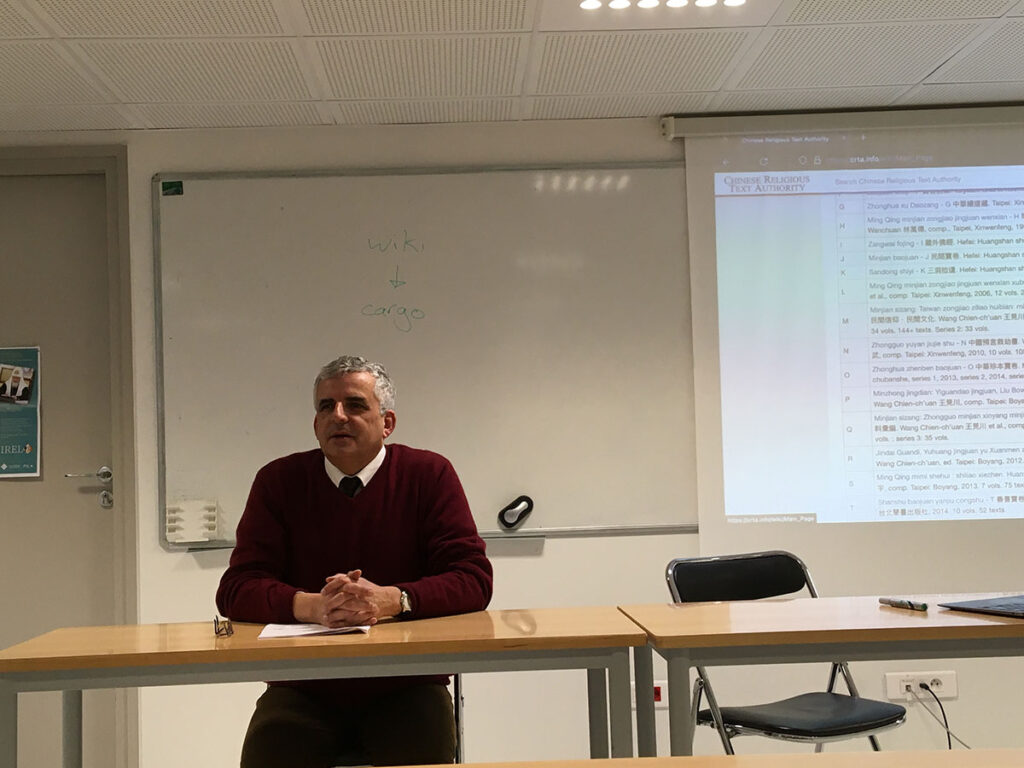
Philip Clart presented the new project “Religious Text Production and Identity Formation in China, 17th to 21st Centuries”. © Q. J. Zheng. Republished with permission.
Daniela Campo (University of Strasbourg) then gave the participants an overview of the workshop agenda in Paris. The workshop is designed to train early-career scholars in database building, text reading, and exchanging information on Chinese religious texts. The workshop would include six presentations by experts in Chinese religious texts on Friday and Saturday mornings. The afternoons of both days would consist of a one-hour database training session followed by short presentations by participants in roundtable discussions. On Sunday, participants would finalize entries in the database.
During the Q&A session, participants were eager to learn more about the CRTA project and related tasks. The instructors provided further explanations for these queries. They reminded the participants that the CRTA website is a catalogue or an index of texts, in which each text’s page body includes bibliographic sections such as title(s), place(s) of publication, publication date(s), contents, prefaces and postfaces, commentary, etc. The entries can be augmented with additional information and commentary by anyone who is knowledgeable about the texts. There is also a reference section for published research related to the texts. The instructors advised the participants to use the CRTA in a way that aligns with their own research goals and to only share information they are comfortable with. Goossaert then emphasized the importance of having a unique page for each edition of a book. He noted that the page should have a standard format and the name of the page should correspond to the Uniform Resource Locator (URL) of the page. The goal is to be able to compare different editions of a book and texts.
The session was followed by several other questions from the audience, including ones on pen names, place names, and entries for gazetteers. The instructors also answered questions about issues such as whether to create a separate page for an edition which is found in multiple collections or link it to the other pages. They emphasized that the priority of phase one of the corpus is to use major reprint collections, but personal collections can be used if a text is not in the phase one corpus.
The first session ended with the participants introducing themselves to the audience. They came from various universities in different countries and shared their research topics in a roundtable presentation. Some of their research topics included the Maoshan 茅山 pilgrimage, liberation of animals, Daoism in Hunan province, Daoist liturgical paintings, patronage and restoration of Daoist temple by spirit-writing groups, monastic ordinations and lineages of the Buddhist Vinaya school, discourses on the unification of five religions in modern China, biographies of Buddhist nuns in the twentieth century, imperial prefaces of Buddhist Canons during the Tang dynasty (618–907), Daoist liturgical manuals [MM1] and medical understandings of different kinds of mushrooms in Daoist texts.
Day 2: Friday January 6th
The second day of the CRTA workshop began at a new venue in the twelfth district of Paris. The conference venue offered a peaceful and scenic setting, being surrounded by greenery, and ideal for a productive workshop. To start the day, three instructors gave talks in the morning.
The first talk was given by Marcus Bingenheimer, who spoke on the textual history and translation of the Longshu jingtu wen 龍舒淨土文 [Writings from Longshu on the Pure Land] (1162 CE, later abbreviated as LSJTW).[8] He started by discussing the evaluation of a text’s importance, mentioning various methods including the consideration of whether it is still used today. LSJTW, for instance, continues to be discussed by contemporary Buddhist figures. Bingenheimer then discussed the relation between text reuse and its importance. He mentioned that citation and quotation are important criteria, but an overlap with other texts does not automatically equal influence (quoting vs. being quoted). To determine a text’s influence, it is necessary to examine its overlap with texts that appeared after it. He introduced “BuddhaNexus”,[9] a tool for finding quotations in a large corpus of text by searching for strings of characters that appear in multiple places. He found that LSJTW has 1047 string overlaps of more than forty characters in the texts of the CBETA corpus, indicating its importance in the development of later Buddhist discourse. He then led us into the life and work of the author of this text, Wang Rixiu 王日休 (1105–1173). The audience was captivated by the complex textual history and a series of portraits of the author in a text titled Nianfo Longshu Wang jushi lihua xiang 念佛龍舒王居士立化像 [Standing Portrait of Householder Wang from Longshu passing while chanting Buddha’s name] in various editions. The text is a collection of ten chapters about Pure Land Buddhism, covering topics such as how to be charitable, the importance of faith, methods of practice, success stories of rebirth in Pure Land, advice for different professions, immediate effects of Amitābha worship, and other miscellaneous topics. Bingenheimer then used three examples to demonstrate the importance of comparing different editions for a better understanding of the text and its translation.
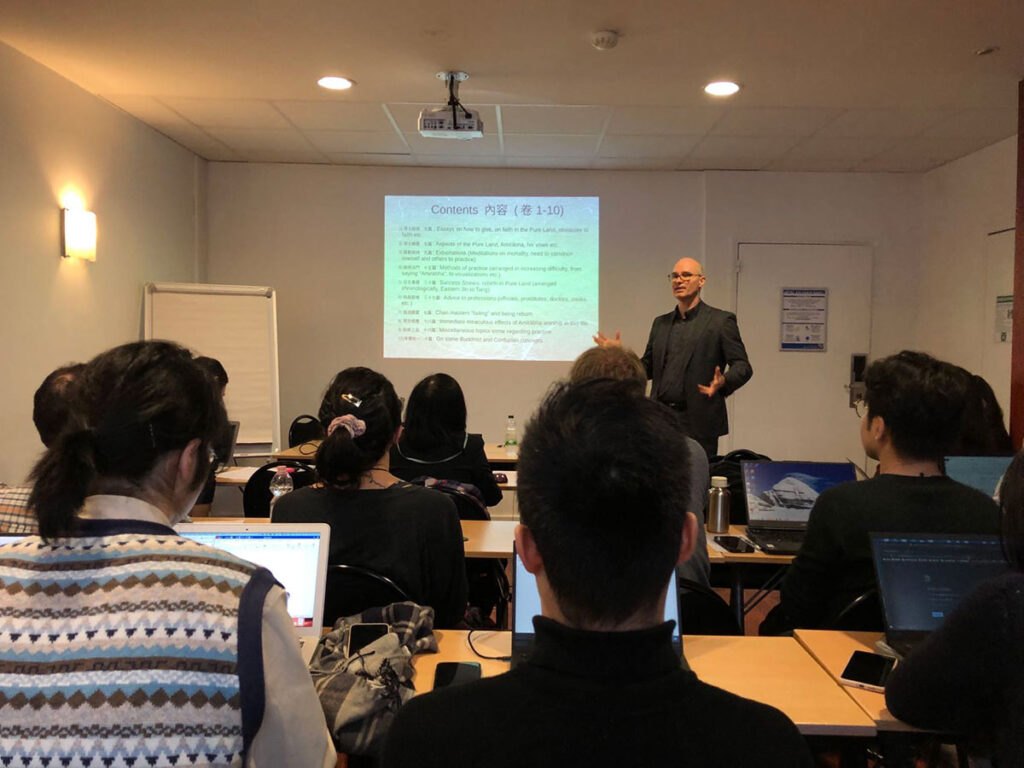
Marcus Bingenheimer’s talk on the textual history and translation of the Longshu jingtu wen 龍舒淨土文 [Writings from Longshu on the Pure Land]. © Richard Ping-i Li. Republished with permission.
Next, Wang Huayan (Institut des Hautes Études Chinoises, Paris) gave a talk titled “Two Stele Inscriptions about Azhali 阿吒力 Buddhist Priests in Dali Region of Yunnan: An Esoteric Buddhism of Bai People”. Wang started by introducing the Azhali priests and the ritual performances for community and domestic events she witnessed from her fieldwork. The Azhali tradition of Buddhism is practiced in southwestern China’s Yunnan region by those who identify as Buddhists but are not necessarily ordained as monks. They perform domestic rituals such as house foundations and funeral ceremonies, as well as official community events. The tradition is passed down from father to son and became incorporated into Chinese culture during the thirteenth century after the Mongol conquest. The priests played an important role in both political and religious domains, but under the Ming dynasty (1368–1644), they lost their privilege as a ruling class and became local religious specialists. Despite limited historical information, some indigenous resources have been preserved, such as the Nanzhaoguo tuzhi 南詔國圖誌 [Illustrative Records of the Kingdom of Nanzhao] and Nanzhao tuzhuan 南詔圖傳 [Illustrated History of Nanzhao], which shows Longshun 隆舜 (r. 878–897) standing before Ācārya Avalokiteśvara (Acuoye guanyin 阿嵯耶觀音) during abhiṣeka—a water ritual of consecration.[10]
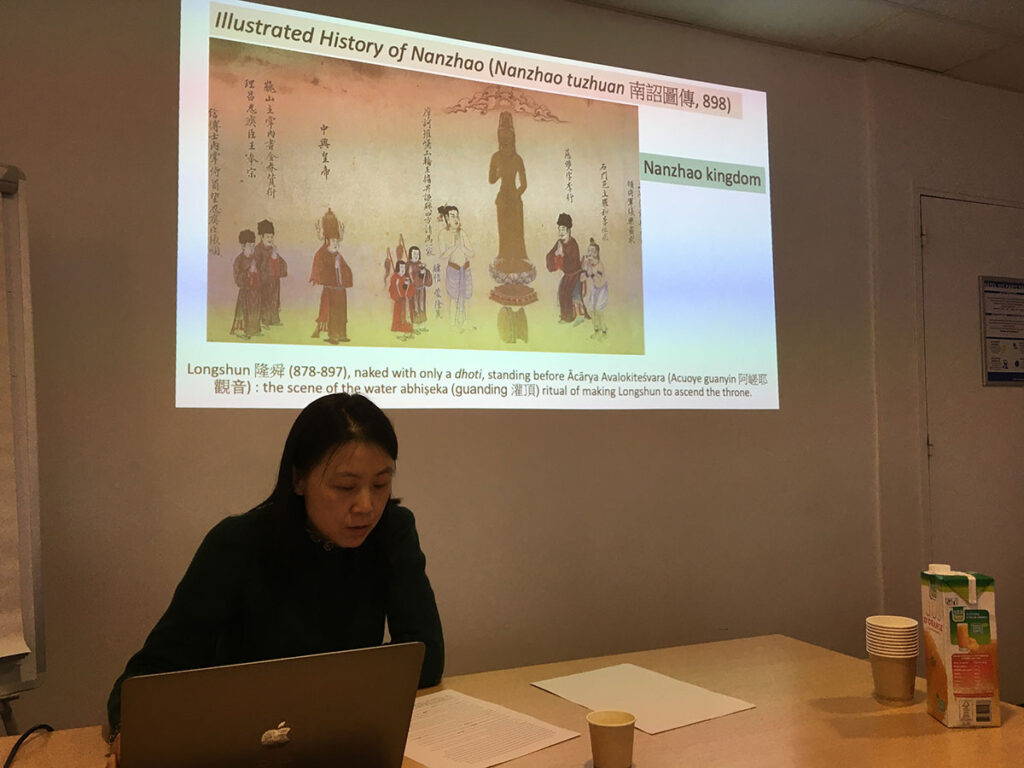
Wang Huayan gave a talk titled “Two Stele Inscriptions about Azhali 阿吒力 Buddhist Priests in Dali Region of Yunnan: An Esoteric Buddhism of Bai People”. © Q. J. Zheng. Republished with permission.
The last talk in the morning was given by Gregory Adam Scott who focused on the topic “Ding Fubao 丁福保 and his Foxue cuoyao 佛學撮要 (Essentials of Buddhist Studies, 1920)”.[11] Scott discussed the relationship between religion, innovation, and change in China, focusing on the life and works of Ding Fubao丁福保 (1874–1952), a well-known Buddhist figure in China. Ding studied both science and Buddhism, and published beginner’s books on the subject, including the Foxue congshu 佛學叢書 [Buddhist Studies Collectanea], which aimed at convincing readers of the existence of spirits, gods, and the reality of karma and rebirth. These books were published through a non-profit model, aiming to reach as many people as possible.
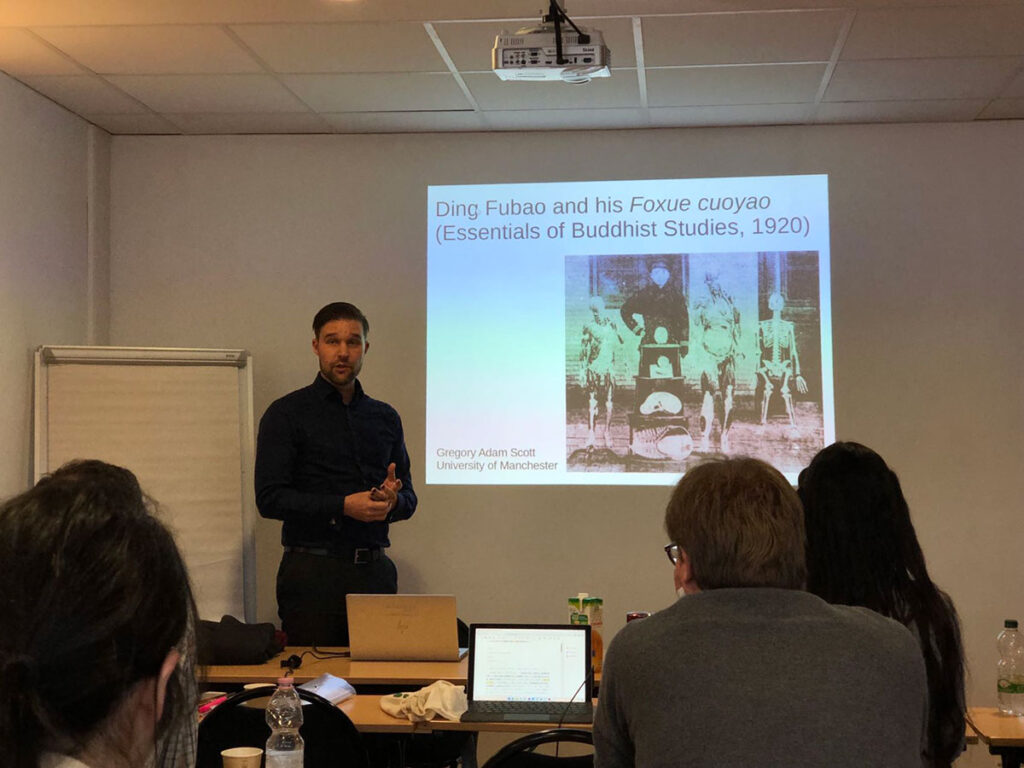
Gregory Adam Scott’s talk “Ding Fubao 丁福保 and his Foxue cuoyao 佛學撮要 (Essentials of Buddhist Studies, 1920)”. © Richard Ping-i Li. Republished with permission.
In the afternoon, Katherine Alexander and Gregory Adam Scott led a training session on wiki editing of the CRTA database. The session started with an explanation of the process of creating a new entry. Alexander provided an overview of the main page, which includes information on user guides, sample item pages, projects, and a list of all corpora. All users have their own user page where they can include professional information and track their contributions. The talk covered creating a new page using MediaWiki markup language and uploading files, with a reminder to limit the size of image file. Alexander described two methods for creating a new entry, either by coding each line, or by copying and pasting a mock entry and then filling in the information, and stressed the importance of saving changes after editing. The most important benefit of using a wiki is that users can easily undo any changes if needed by reverting to a previous saved version of their work.
After the training session on wiki editing of the CRTA database, several round-table presentations of outlier texts by early career scholars took place. They shared the texts that they had chosen to contribute to the CRTA database, including Quanjie tushuo 勸戒圖說 [Illustration for the Exhortation of Precepts] (1594), Wangmu xiaojie jiushi zhenjing王母消劫救世真經 [The Disaster Elimination and World Salvation Canon of Queen Mother], works by Xia Lianju 夏蓮居 (1894–1965), Lümen zuting huizhi 律門祖庭彙誌 [Collected Gazetteer of the Patriarchal Domain of the Vinaya Tradition], Xizhanlun 息戰論 [Treatises on Armistice], Xu biqiuni zhuan 續比丘尼傳 [The Continued Biographies of Nuns], Zhengyi baibiao keshu 正一拜表科書 [Zhengyi Liturgical Manual of Submitting Petition], and Guanshiyin pusa ganyingling ke 觀世音菩薩感應靈課 [The Efficacious Divination from Bodhisattva Avalokitesvara’s Sympathetic Resonance].
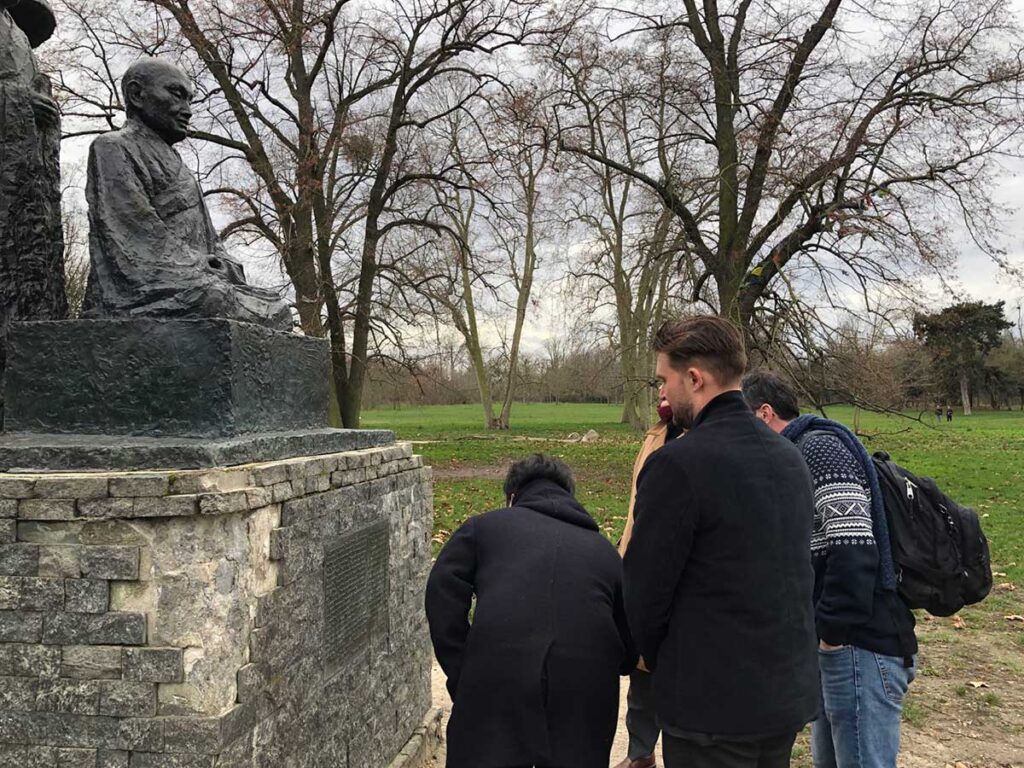
“Pèlerins des nuages et de l’eau / Unsui Gunzo 雲水群像”, a bronze sculpture representing a group of Buddhist pilgrims. Created in 1971 by Japanese artist Torao Yazaki 矢崎虎夫 (1904–1988), located in the Bois de Vincennes. © Richard Ping-i Li. Republished with permission.
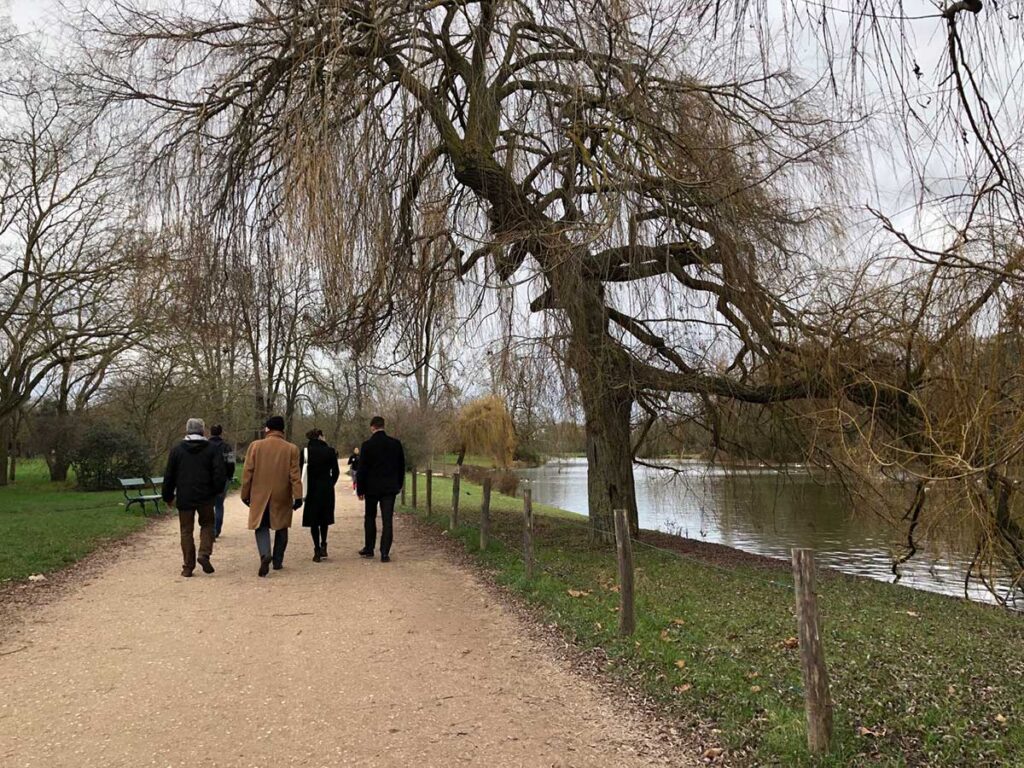
Richard Li: “I love this photo. It’s like our teachers leading the way and guiding us.” © Richard Ping-i Li. Republished with permission.
Day 3: Saturday January 7th
Vincent Goossaert started the day with his talk on Wen datianjun shouwen jiangfu baochan 溫大天君收瘟降福寶懺[Precious Litany for Dispelling Plagues and Creating Blessings by Great Heavenly Lord Wen][12] by discussing the significance of litany rituals performed in Chinese communities to the epidemic gods.[13] He emphasized that despite being understudied in academic circles, these rituals are important and meaningful practices to ordinary people. He then traced the history of litany liturgies, connecting them to Buddhism and explaining how they involve confession and repentance. In the Chinese context, the confessions are not as detailed nor as specific, but rather, they usually list all common sins and the participants could take vows to not do them again, or to regret all committed sins consciously or unconsciously. These rituals could be done either individually or collectively and are usually performed at the beginning of a larger ritual to cleanse oneself and make one eligible to participate in the rest of the ritual. The earliest litanies appeared in the fourth to fifth centuries in a Daoist context, where the litanies were more general and addressed all supernatural entities. During the early modern period in the tenth to eleventh centuries, there emerged new individual deity cults. The litanies that appeared during this period addressed specific issues, such as fire, droughts, or epidemics. Women also started to have their own specific gods to worship. New gods acquired their own litanies, and the believers created a bond with the gods through the recitation of their litanies. We were also introduced to spirit-writing, in which the main genre developed from the eleventh century onward and gained traction around the sixteenth century.[14] Spirit-writing groups perform these litanies as they do not need too much training and are relatively flexible to perform. These litanies, with close connections to morality books, advocate moral values for the group. The litany discussed in the talk was written in simple language and addressed the concern of society during major epidemics. These epidemics were believed to be caused by people’s wickedness and sinfulness, which opened doors to evil spirits. These attitudes reflected a moralistic understanding of illnesses and death.
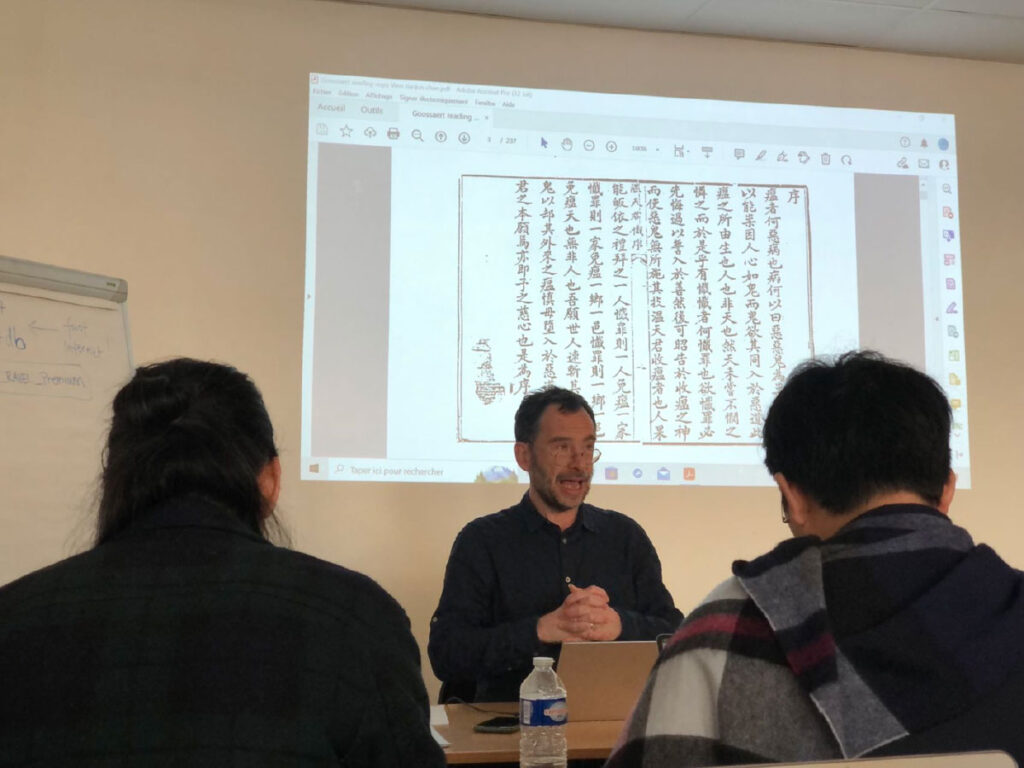
Vincent Goossaert’s talk on Wen datianjun shouwen jiangfu baochan 溫大天君收瘟降福寶懺 [Precious Litany for Dispelling Plagues and Creating Blessings and by Great Heavenly Lord Wen] and litany rituals performed in Chinese communities to the epidemic gods. © Richard Ping-i Li. Republished with permission.
Philip Clart’s talk focused on the genre of Chinese morality books called shanshu 善書, using Xunnü baozhen 訓女寶箴 [Precious Admonitions for the Instructions of Women] as an example. These books aimed at reforming the public’s morals and were primarily based on Confucianism, emphasizing virtues such as filial piety, loyalty, and righteousness. The tradition of morality books dates to the Song dynasty (960–1279), when society underwent major changes and established new moral norms. The production of morality books increased during times of social and moral disorder and saw a surge in response to the cultural crisis caused by Western imperialism in the nineteenth century. Today, religious groups provide institutional support for the production of morality books, and a significant portion of these books are produced through spirit-writing. Clart noted that morality books are not just reflections of social conditions but are also commentaries and critiques of their time. They represent one mode of response to the forces of change in Chinese culture and are an important part of cultural conservatism. Clart then led the participants in reading the text of Xunnü baozhen together, looking for bibliographic information, which was later incorporated into an entry on the CRTA.
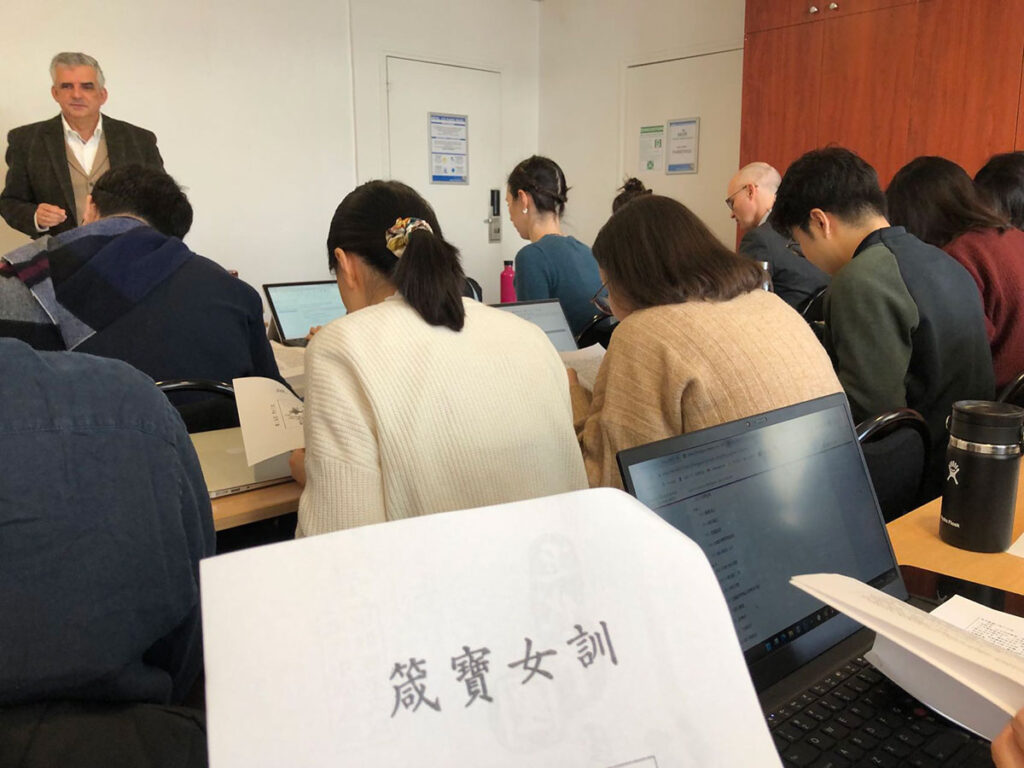
Philip Clart’s talk focused on Chinese morality books called shanshu 善書, using Xunnü baozhen 訓女寶箴 [Precious Admonitions for the Instructions of Women] as an example. © Richard Ping-i Li. Republished with permission.
The talk by Katherine Alexander was about a precious scroll (baojuan 寶卷) titled Liu Xiang zhongjuan 劉香中卷[Middle scroll of Liu Xiang], which is an outlier because its existence as a work separate from its parent text, Liu Xiang baojuan 劉香寶卷 [Precious Scroll of Liu Xiang].[15] While doing archival research, Alexander found two texts titled Liu Xiang zhongjuan 劉香中卷 which were mislabeled by their holding library as Liu Xiang baojuan 劉香寶卷, and were not catalogued by Che Xilun 車錫倫 (b.1937) in his authoritative work Zhongguo baojuan zongmu 中國寶卷總目[Catalogue of Chinese Precious Scrolls]. She then explained that these two editions were also very different from each other, with one being longer and missing paratextual information, and the other being shorter but including paratextual information and a title page. From the 1873 preface, we learnt that the second edition was heavily edited by Yu Zhi 余治 (1809–1874), including removing significant episodes. Focusing on the concluding story in the longer edition, which Yu cut entirely from his edition, Alexander led participants to look at versions of the same ghost story plot found in various other works such as Xuetang riji tushuo 學堂日記圖說 [Illustration of School Diary], Xu qianjiashi續千家詩 [Sequel to Poems by a Thousand Poets] and Nü ershisixiao tushuo 女二十四孝圖說 [Illustration of Twenty-four Filial Exemplars for Women], all compiled by Yu Zhi. By reading and analysing these texts as a group, Alexander asked participants to consider what could Yu’s objection have been to the original conclusion by identifying differences in the stories’ details such as gender, reasons for suicide, and the ways to rescue ghosts, in order to see how the author of the longer version of Liu Xiang zhongjuan 劉香中卷 added objectionable elements to what had previously been a straightforward morality tale.
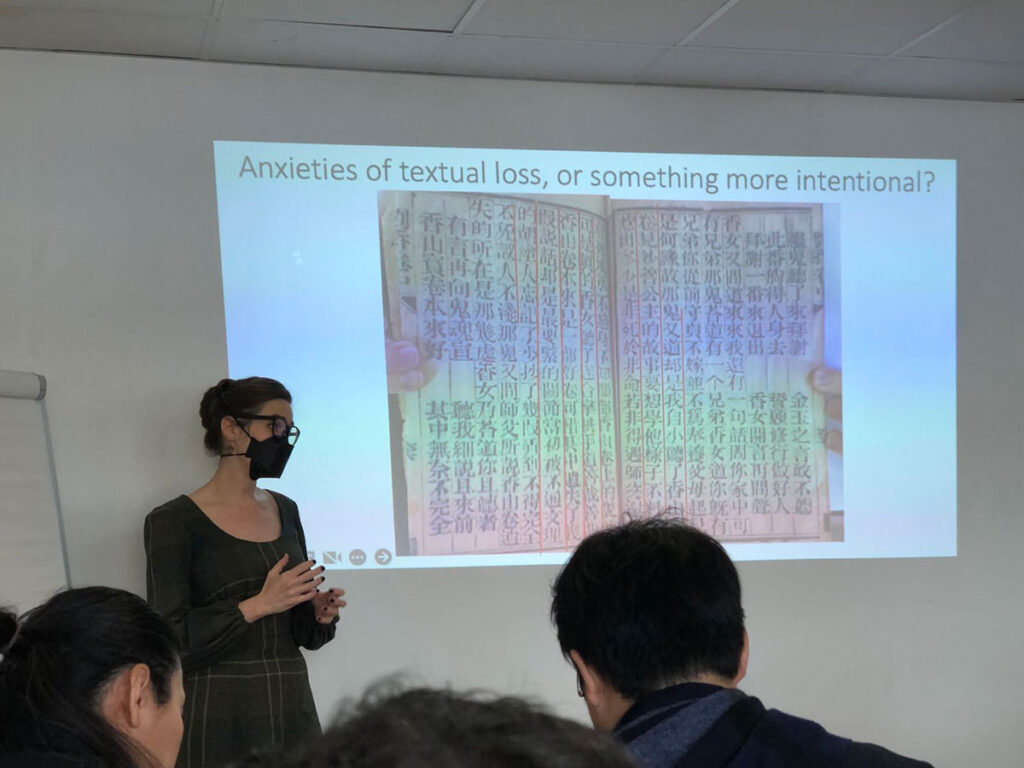
Katherine Alexander’s talk on a study of precious scrolls (baojuan 寶卷) titled Liuxiang zhongjuan 劉香中卷 [Middle Scroll of Liu Xiang]. © Richard Ping-i Li. Republished with permission.
In the afternoon, we heard a few more presentations from participants on texts which they considered an “outlier” such as: the Buddhist periodical Haichaoyin 海潮音 [Sounds of the Sea Tide], Xingxue kaimeng 性學開蒙 [Primer to the Learning of Inherent Nature], Yuzhi zhongkan zangjing xu 御制重刊藏經序 [Imperial Preface of the Qing Buddhist Canon], Taishang ganying pian tushuo 太上感應篇圖說 [Illustrated Explanation of Verses from the Most High on Action and Retribution], Jinke jiyao 金科輯要 [Compendium of the Golden Rules], Lüzushi jiangyu zunxin yuli chaozhuan yanwangjing 呂祖師降諭遵信玉歷鈔傳閻王經 [Patriarch Lü Descending with Orders Exhorting the World to Follow the Legend of Jade Calendar and Sūtra of Yan wang], Chongjian Jinling Yuxuguan zhengxinlu 重建金陵玉虛觀徵信錄 [Records of Donation for the Reconstruction of Yuxuguan in Jinling], and Taishang lingbao zhicao pin 太上靈寶芝草品 [Catalogue of Numinous Treasure of Mushroom Plants from the Most High].[16]
Day 4: Sunday January 8th
The final day of the workshop was dedicated to validating entries for the CRTA website, which was led by Katherine Alexander and Gregory Adam Scott. They provided hands-on guidance on the formatting and technical requirements for adding entries to the website, giving participants more confidence to contribute after the workshop. Vincent Goossaert also announced that there would be more CRTA workshops in the future, both in-person and online.
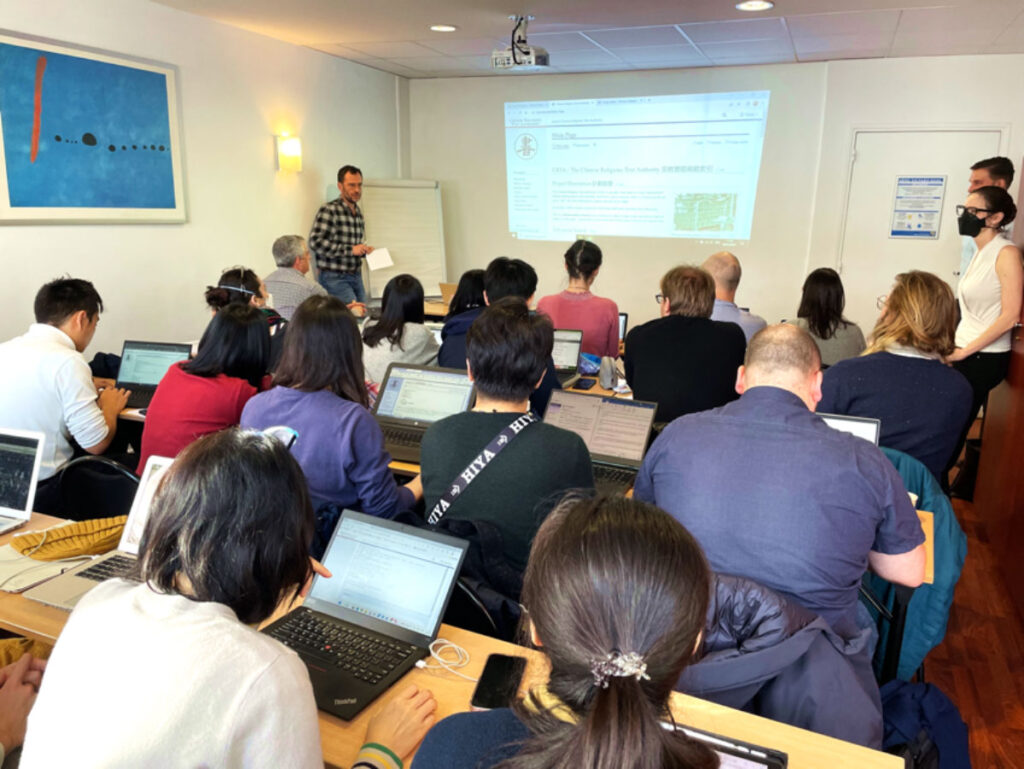
Vincent Goossaert sharing his vision for the future of the CRTA project. © Q. J. Zheng. Republished with permission.
Throughout the CRTA workshop in Paris, participants were given the chance to engage with leading experts in Chinese religions from around the world. The conference provided more than just academic exchange, with coffee breaks, group lunches and dinners allowing scholars to discuss their research topics, solicit feedbacks, and share new research tools and databases, or any other topics in an informal setting. Goossaert led several invigorating scenic walks and excursions to nearby parks and gardens during breaks. He also expertly blended textual study during the workshop with site visits to the vibrant Chinatown in Paris to bring the subject matter to life. There, participants had the unique opportunity to visit two distinct temples, the “Autel de culte de Bouddha 法國巴黎觀音玄武山佛祖神壇” and the “Amicale des Teochew en France 法國潮州會館”, gaining first-hand experience of Chinese religions as they are practiced in France. The CRTA workshop aimed not only at building an online database, but also at creating a community of scholars with a shared passion for understanding Chinese religious texts, regardless of geographical location. The workshop provided participants with a rich and unforgettable learning experience, and all participants were grateful for the excellent organization by Daniela Campo and the sponsors of this event. Participants and instructors of the CRTA project warmly encourage and welcome scholars interested in Chinese religions to attend future workshops.
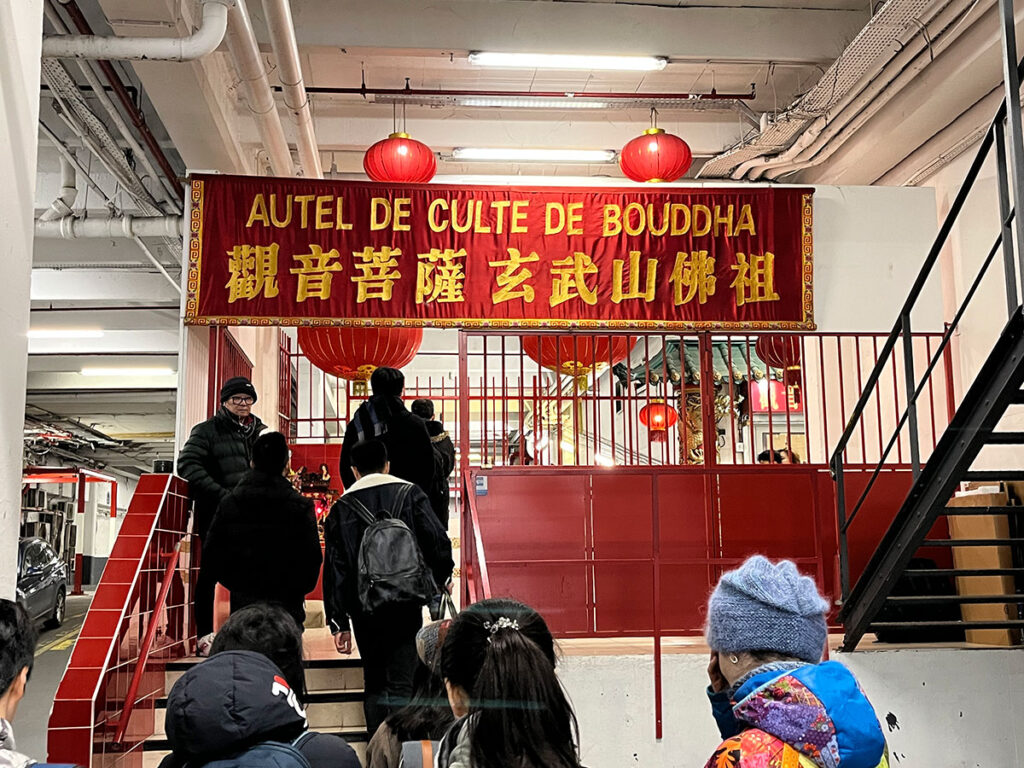
Participants visiting Autel de culte de Bouddha 法國巴黎觀音玄武山佛祖神壇. © Renju Guo. Republished with permission.
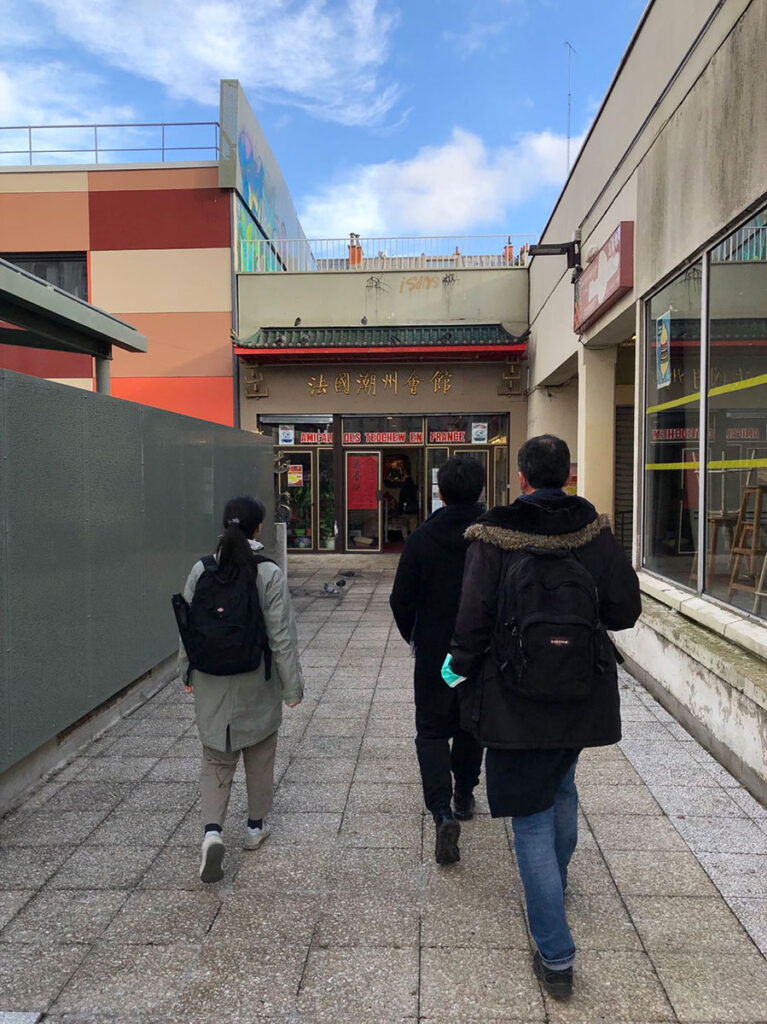
Participants visiting Amicale des Teochew en France 法國潮州會館. © Richard Ping-i Li. Republished with permission.
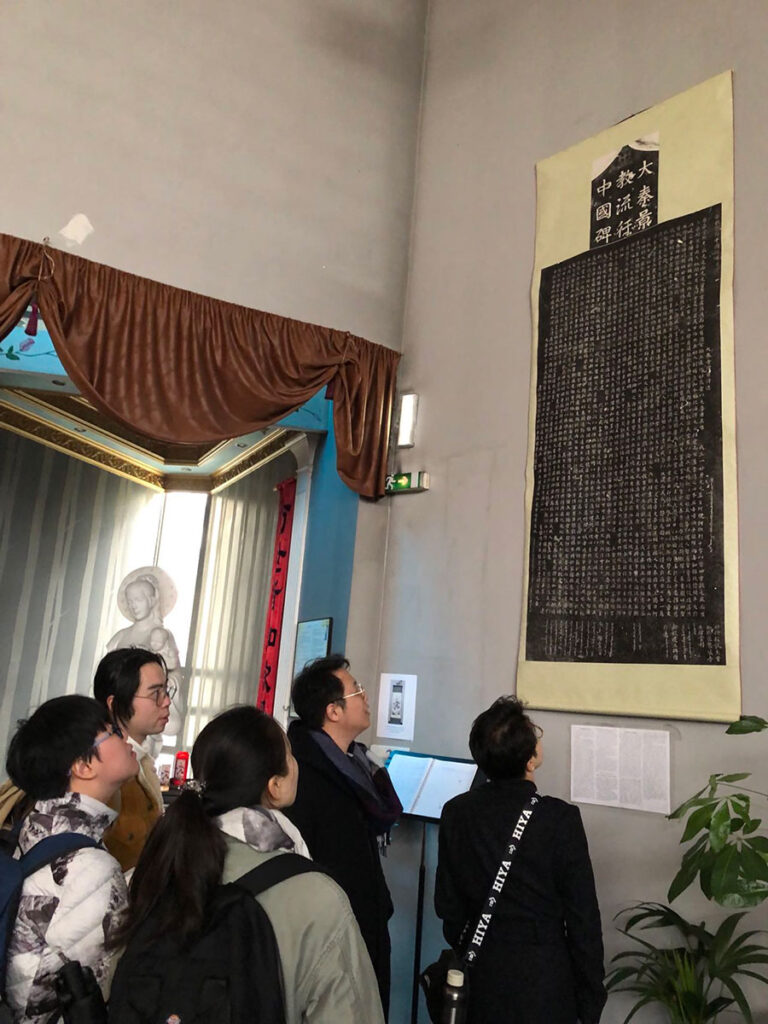
Participants reading a stele rubbing at Notre-Dame de Chine 中華聖母堂教會. © Richard Ping-i Li. Republished with permission.
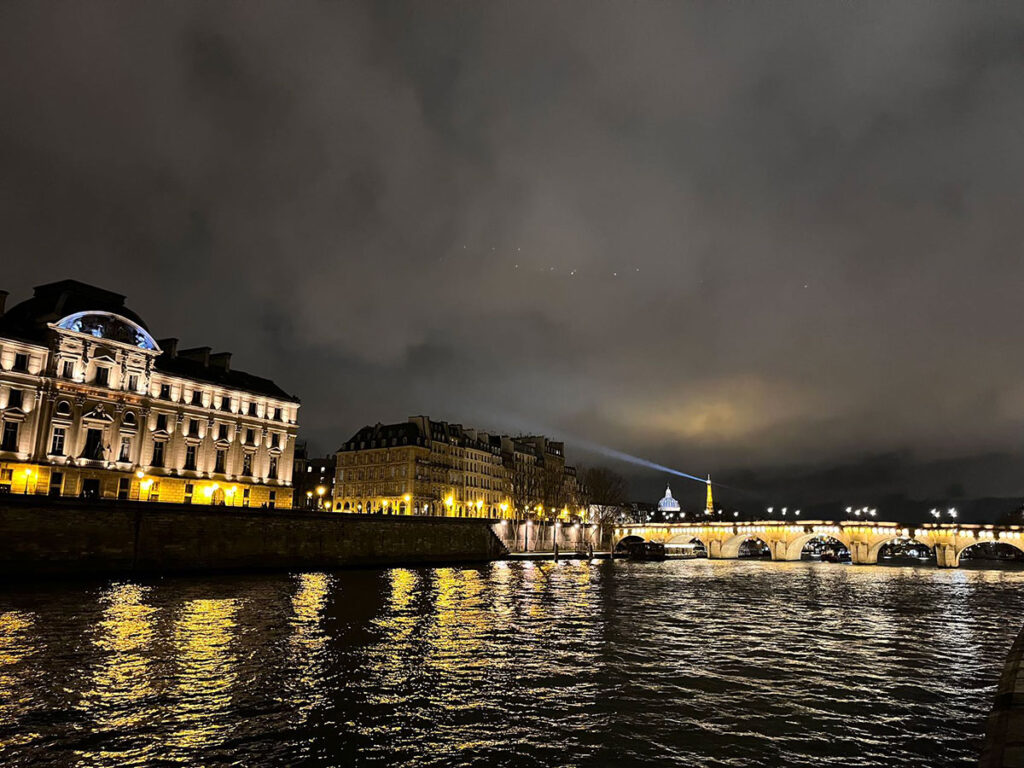
Night walk in Paris, City of Light. © Renju Guo. Republished with permission.
Author Bio: Q. J. Zheng is a graduate student in Religious Studies at École Pratique des Hautes Études – PSL in Paris, France. He specializes in the history of Taoism and Esoteric Buddhism. Adopting a historical-anthropological methodology, his research explores pilgrimage, sacred geography, apocalyptic and prognosticative ideas from a longue duréeperspective. He is an avid walker and has undertaken many pilgrimages around the world.
Bibliography
Abbreviations
DZ = Zhengtong daozang 正統道藏, number according to The Taoist Canon: A Historical Companion to the Daozang(Daozang Tongkao 道藏通考), edited by Kristofer Schipper and Franciscus Verellen. Chicago: University of Chicago Press, 2004. See Primary source, Zhengtong Daozang.
T = Taishō shinshū daizōkyō 大正新脩大藏經. See Bibliography, Secondary Sources, Takakusu and Watanabe, eds.
Primary Source
Zhengtong Daozang 正統道藏 [Daoist Canon Compiled during the Zhengtong Reign (1436–1449)]. 5305 juan. Compiled by Zhang Yuchu 張宇初 (1359–1410) et al., in 1445. Rpt. Taipei: Xinwenfeng, 1977.
Secondary Sources
Alexander, Katherine L. “An Excerpt from The Precious Scroll of Liu Xiang”. Journal of Chinese Buddhist Studies, no. 34 (2021): 27–62.
———. “Conservative Confucian Values and the Promotion of Oral Performance Literature in Late Qing Jiangnan: Yu Zhi’s Influence on Two Appropriations of Liu Xiang Baojuan”. CHINOPERL Papers 36, no. 2 (2017): 89–115.
———. “The Precious Scroll of Liu Xiang: Late Ming Roots and Late Qing Proliferation”. Journal of Chinese Religions49, no. 1 (2021): 49–74.
———. “Virtues of the Vernacular: Moral Reconstruction in Late Qing Jiangnan and the Revitalization of Baojuan”. Ph.D. dissertation, University of Chicago, 2016.
Bryson, Megan. “Images of Humane Kings: Rulers in the Dali-Kingdom Painting of Buddhist Images”. In Buddhist Statecraft in East Asia, edited by Stephanie Balkwill and James A. Benn, 87–118. Leiden: Brill, 2022.
Chinese Religious Text Authority. “溫大天君收瘟降福寶懺 – K85” Wen datianjun shouwen jiangfu baochan [Precious Litany for Dispelling Plagues and Creating Blessings by Great Heavenly Lord Wen].
https://crta.info/wiki/%E6%BA%AB%E5%A4%A7%E5%A4%A9%E5%90%9B%E6%94%B6%E7%98%9F%E9%99%8D%E7%A6%8F%E5%AF%B6%E6%87%BA_-_K85
Clart, Philip, and Gregory Adam Scott, eds. Religious Publishing and Print Culture in Modern China: 1800–2012. Boston: De Gruyter, 2015.
European Association for Chinese Studies. “Vacant Positions (PhD and Postdoc), Project
‘Religious Text Production and Identity Formation in China, 17th to 21st Centuries’”. Accessed February 9, 2023. https://chinesestudies.eu/2023/vacant-positions-phd-and-postdoc-project-religious-text-production-and-identity-formation-in-china-17th-to-21st-centuries/.
FROGBEAR. “Chinese Religious Text Authority (CRTA) workshop on reading late imperial
Chinese religious texts and database building”. Accessed February 9, 2023. https://frogbear.org/call-for-applications-chinese-religious-texts-authority-crta-workshop-on-reading-late-imperial-chinese-religious-texts-and-database-building/.
Gao Wansang 高萬桑 (Vincent Goossaert). “Zongjiao shuji guifan suoyin – CRTA jihua jianjie” 宗教書籍規範索引(CRTA) 計劃簡介 [Introduction to the Chinese Religious Texts Authority (CRTA) Program]. Shanshu, jingjuan yu wenxian 善書, 經卷與文獻 [Morality Books, Scriptures and Texts] 1 (2019): 91–8.
Goossaert, Vincent. Making the Gods Speak: The Ritual Production of Revelation in Chinese Religious History. Cambridge: Harvard University Press, 2022.
———. “Spirit-writing altars and Daoist rituals in Qing Jiangnan”. Studies in Chinese Religions 8, no. 3 (2022): 385–406.
Katz, Paul R. Demon Hordes and Burning Boats: The Cult of Marshal Wen in Late Imperial Chekiang. Albany: State University of New York Press, 1995.
Salguero, C. Pierce, Robban Toleno, William J. Giddings, Joshua Capitanio, and Marcus Bingenheimer. “Medicine in the Chinese Buddhist Canon”. Asian Medicine: Journal of the International Association for the Study of Traditional Asian Medicine 12, no. 1–2 (2017): 279–94.
Scott, Gregory Adam. “Conversion by the Book: Buddhist Print Culture in Early Republican China”. Ph.D. dissertation, Columbia University, 2013.
———. “Navigating the Sea of Scriptures: The Buddhist Studies Collectanea, 1918–1923”. In Religious Publishing and Print Culture in Modern China: 1800–2012, edited by Philip Clart and Gregory Adam Scott, 91–138. Boston: De Gruyter, 2015.
Takakusu Junjirō 高楠順次郎, and Watanabe Kaigyoku 渡邊海旭, eds. Taishō shinshū daizōkyō 大正新修大藏經[Buddhist Canon Compiled during the Taishō Era (1912 –1926)]. 100 vols. Tokyo: Taishō issaikyō kankōkai 大正一切經刊行會, 1924 –1932. Digitized in CBETA (v. 5.2) (https://www.cbeta.org) and SAT Daizōkyō Text Database (http://21dzk.l.u-Tōkyō.ac.jp/SAT/satdb2015.php).
[1] I am very grateful to Carol Lee and reviewers of the FROGBEAR project (University of British Columbia) and members of the steering committee of CRTA project, especially Katherine Alexander and Daniela Campo for their detailed and helpful comments on an early draft of this paper. While every effort has been made to ensure the accuracy of the content, any errors or inaccuracies that may remain are solely the responsibility of my own. For a comprehensive and authoritative understanding of the topics covered in the workshop, readers are encouraged to consult the instructors’ published work, including but not limited to those cited in the bibliography.
[2] For more details about this workshop, see FROGBEAR, accessed February 9, 2023, “Chinese Religious Text Authority”.
[3] For more about CRTA, see https://crta.info; and Gao, “Zongjiao shuji guifan suoyin”.
[4] See Scott, “Conversion by the Book”; Clart and Scott, Religious Publishing.
[5] See Chinese Text Project, accessed February 9, 2023, https://ctext.org.
[6] For more details, see European Association for Chinese Studies, accessed February 9, 2023, “Vacant Positions”.
[7] Ibid.
[8] For an excerpt from Quan yizhe 勸醫者 [Advice to Doctors] from the Longshu zengguang jingtu wen 龍舒增廣淨土文 [Expanded Pure Land Writings by the Master from Longshu], T. 1970, 47: 270b02–26), translated and introduced by Marcus Bingenheimer, see Salguero et al., “Medicine in the Chinese Buddhist Canon”.
[9] See BuddhaNexus, accessed February 9, 2023, https://buddhanexus.net.
[10] For a recent study on rulers in the Dali-Kingdom Painting of Buddhist Images, see Bryson, “Images of Humane Kings”.
[11] Scott, “Navigating the Sea of Scriptures”.
[12] Chinese Religious Text Authority, “溫大天君收瘟降福寶懺 – K85”. See also Goossaert, “Spirit-writing altars and Daoist rituals in Qing Jiangnan”.
[13] For more on Marshal Wen’s cult, see Katz, Demon Hordes and Burning Boats.
[14] For more on spirit-writing, see Goossaert, Making the Gods Speak.
[15] For more detailed study on Liu Xiang baojuan, see Alexander, “Virtues of the Vernacular”; “Conservative Confucian Values”; “The Precious Scroll”; “An Excerpt”.
[16] DZ 1406.
Click here for the original posting








